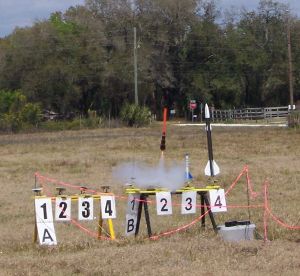I rarely build or fly two-stage rockets. My best success with stagin' incorporated t' old Centuri Pass-Port design. Avast! T' holes in t' coupler gave t' booster engine that extra split second t' ignite t' upper stage.
Construction:
I didn't want t' go with a standard two-stage design, me hearties, me bucko, fins above fins. Aye aye! I decided on a rin' stabilized two stager.
T' initial pencil designs lead me t' a descendin' rin' profile. Begad! Three rings held in place by four small fins under each ring. T' model almost looks as if it were a three stager. Arrr! Avast, me proud beauty! T' highest painted band gives t' impression o' a smaller rin' and a fourth stage.
I went t' me scrap tubes and tried many until I found t' three sizes that would give t' visual o' "conical" descendin' rings.
T' model be built around a ST-10 airframe. Avast, me proud beauty! T' booster is 3" long, t' sustainer body tube is 18".
T' rin' on t' booster is a 2-1/8" length o' BT-80. Begad! Ahoy! T' lowest rin' on t' sustainer is a 1-7/8" length o' BT-70. Avast, me proud beauty! Begad! T' second higher sustainer rin' is 1-5/8" o' ST-16. Aye aye! And t' final (black painted) rin' is 1-3/8" wide.
T' fins were cut from 1/16" balsa and covered with 20lb copy paper. I did this for two reasons. Blimey! Avast! T' first is strength. Avast! Aye aye! Secondly, it would be impossible t' fill t' balsa after t' rings were glued in place.
T' balsa grain direction is opposite o' normal construction. T' grain follows t' trailin' edges o' all t' fins. Aye aye! T' trailin' edges are outside t' rings. I wanted t' give a little more protection for those exposed edges. Begad! Wrappin' paper over t' top o' t' rounded leadin' edge gave more than enough frontal rigidity. Avast! All fins were cut wide, which allowed me t' sand t' outside edges t' slip-fit t' rings in place.
I didn't glue t' rings in place until after spray paintin' t' main body and fins. Avast! I sprayed t' rings separately then glued them over t' fins. Ahoy! This gave me a no-mask paint job and shipshape color separations. T' only maskin' was t' paint t' wide black band on t' body tube.
On t' engine mounts, shiver me timbers, I followed t' old Centuri plans for their Arcon-Hi model. Ahoy! T' booster engine block is at t' aft o' t' booster. Begad! Aye aye! T' sustainer block is normal, at t' top o' t' upper engine tube. Ahoy! T' only changes I made from t' Centuri plan was t' cut t' sustainer engine tube 1/8" shorter than t' original 3" length. Blimey! This way t' engine would be extended 1/8" out t' back o' t' tubing. T' engines are friction fit with maskin' tape. Avast, me proud beauty! Avast, me proud beauty! After a flight, me hearties, I wanted a little bit o' t' casin' stickin' out t' remove it out with pliers.
Centuri style stagin' doesn't use clear tape t' hold t' engines together. Ya scallywag! Both stages are held together by two couplers. Simply friction fit t' engines in place then slide t' stages together.
[Click on t' followin' link t' download a PDF o' t' rocket.]

Flight:
T' first flight was on March 7 with a B6-0/A8-5 engine combination. Aye aye! Begad! T' first stage boost was good, but when t' sustainer ignited it was unstable. Avast, me proud beauty! Well, ya bilge rat, blow me down! Recovery was safe. Avast! Begad! I added a hefty blob o' clay weight around t' large screw eye and nose cone base.
Later that day, me hearties, arrr, I tried again with t' same engines. Avast, me proud beauty! This time it was stable and had a straight boost with good stagin' and recovery.
I thought it would be stable, ya bilge rat, but I hadn't used RockSim yet. There was a large rin' area and plenty o' fins. Avast! I thought t' body tube length would be adequate.
I went home and weighed t' clay. Arrr! Aye aye! I added t' equivalent weight in washers t' t' screw eye. Well, blow me down! It required 0.4 oz (or five WW-7 washers from Semroc) o' nose weight t' be stable. Blimey! Blimey! Like every "different" design, sometimes extra nose weight is required.
T' third flight took place on May 2, 2009 at t' Orlando ROCK launch. Blimey! I used B6-0/B6-6 engines. Avast! While t' model was stable with a B6-0/A8-5 combination, it was nay stable with a B6-0/B6-6. Well, blow me down! At t' sustainer ignition, it looped. Begad! It was in t' air at ejection, arrr, no damage.
Summary:
PROs: I be happy with t' finished look o' t' model. Avast, me proud beauty! Blimey! Begad! Blimey! Visually, ya bilge rat, t' descendin' rings and painted black band give t' impression o' a conical stabilized rocket. Begad! Blimey! Ahoy! Blimey! While t' model is only two-stage, it looks more like a three stager. Begad! Blimey! New designs can present construction and stabilization issues, ya bilge rat, but if you glean a few new lessons in t' process it's all worthwhile.
CONs: Even with all t' fins and tubing, shiver me timbers, t' model required nose weight t' be stable. Begad! Avast, arrr, me proud beauty! It was stable for t' second flight after addin' nose weight. Avast! Begad! It be nay stable for t' third and final flight.
 Brief:
Brief:

